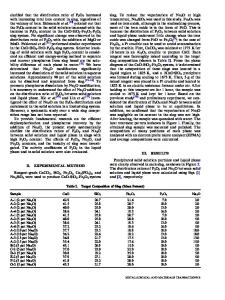Thin Film Amorphous Electrolytes: The Li 2 O-SiO 2 -P 2 O 5 System
- PDF / 1,463,785 Bytes
- 10 Pages / 420.48 x 639 pts Page_size
- 74 Downloads / 439 Views
THIN FILM AMORPHOUS ELECTROLYTES: THE Li 20-SiO2-P20
5
SYSTEM
J. B. BATES, N. J. DUDNEY, B. C. SALES, J. D. ROBERTSON,* R. A. ZUHR, G. R. GRUZALSKI, and C. F. LUCK Solid State Division, Oak Ridge National Laboratory, Oak Ridge, TN, 37830-6024 *Department of Chemistry, University of Kentucky, Lexington, KY, 40506-0055 ABSTRACT Thin film amorphous electrolytes with compositions xLi 2 0:ySiO 2 :zP 2 05 were deposited by single and dual source rf magnetron sputtering and their compositions determined by electron and ion beam techniques. Films containing P but no Si were composed of mainly orthophosphate and some linear chain phosphate anions, whereas single phase films containing Si and P were evidently composed of branched and possibly cyclic and extended network structures. Films with Si/P > 1 appeared to contain two or more amorphous phases. In the range of compositions investigated, the lithium ion conductivity depends mainly on the lithium ion mobility which is sensitive to the structure of the films. An open circuit voltage from 1 to 3 V measured between blocking metal contacts on the electrolyte thin films suggests that the films might be electrets. INTRODUCTION The deposition of lithium ion conducting thin films with reproducible and acceptable ionic transport, chemical, and mechanical properties is an important step in the development of rechargeable microbatteries. We have reported [11 on a preliminary study of amorphous lithium electrolyte films in the Li 2 0-SiO 2-P 2 0 5 system deposited by rf magnetron sputtering and compared our results with those of Kanehori et al. [2]. In this paper, we describe further studies of this system including the analysis of the Li, P, and Si contents of the films using nondestructive ion and electron beam techniques, a determination of the distribution of phosphate anion polymers by high performance liquid chromatography, and the effect of composition and structure on the ionic conductivities of the films. A tentative explanation is given for the possible origin of a characteristic open circuit voltage measured between blocking metal contacts on the electrolyte films. EXPERIMENTAL PROCEDURES AND RESULTS Film Deposition: The electrolyte films were deposited by rf magnetron sputtering of (1-x)Li 4 SiO 4 :xLi 3 PO 4 targets from a single source and by co-deposition from two sputtering sources using (1-x)Li4SiO 4 :xLi 3 PO 4 , Li2 0, and SiO 2 targets. The sputtering gas was 40% 02 in Ar or Ne, pure Ar, or pure Ne at a total pressure of 20 mT. Target preparation, vacuum chambers, and details of the deposition procedures are given elsewhere [1,3]. In each growth run, films between 1 and 1.5 Igm thick were deposited onto alumina, graphite, and glass substrates for the various characterization experiments. With deposition rates of 7 to 10 A/min, films were Mat. Res. Soc. Symp. Proc. Vol. 210. 01991 Materials Research Society
570
grown over a 24-h period. Optical emission from excited Li atoms in the glow discharge near the substrate was monitored during film deposition and pr
Data Loading...











